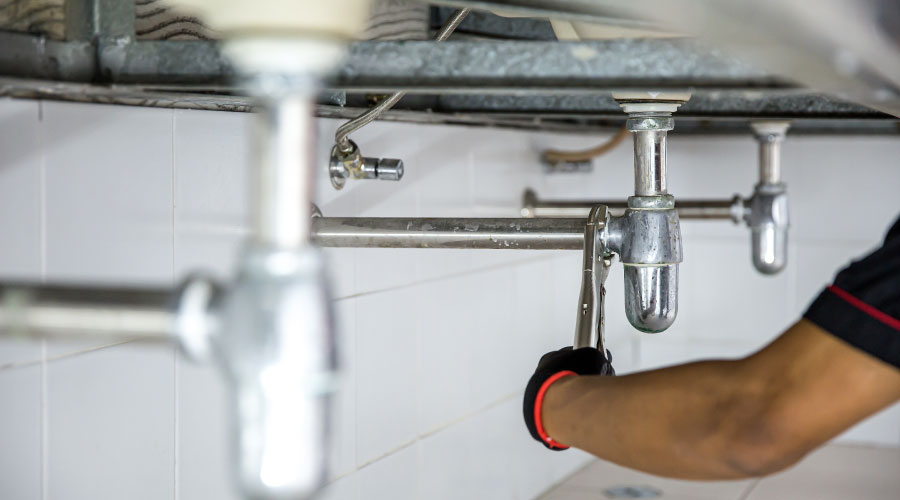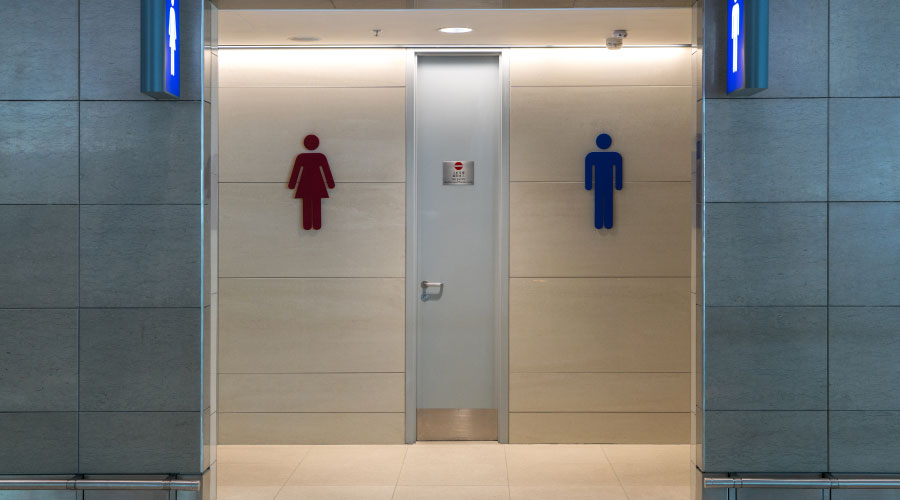Nightmares Into Pipe Dreams
Efficiently addressing problems with drains and piping systems can result in lower water costs and smoother facility operations
Maintenance managers often dread the phone call: “A pool of water is collecting around our drain.”
While inconvenient and messy, clogged drains usually are easy to correct, provided the department has the proper equipment and technical knowledge. Increasingly, departments are complementing time-tested equipment with advanced technology designed to increase worker efficiency. Maintenance technicians now have many opportunities to better serve their customers, solve their drain problems more efficiently and boost drain-cleaning effectiveness.
Kinetic Water Rams
These lightweight tools can quickly open clogged toilets, sinks and tubs with lines up to 4 inches in diameter. They use a burst of compressed air that drives a shock wave — kinetic energy — through the water to break up stoppages.
This style of ram has a self-contained pump and pressure gauge to ensure that technicians can hit the stoppage with the right amount of force with an instant impact but with no buildup of pressure in the plumbing system. The force then is transmitted through the water, so it usually is not affected by the presence of stacks or vents.
Mini-jetters
Mini-jetters now are priced to fit within many facilities’ budgets. Jetting does something a cable doesn’t: It removes buildup in the lines caused by rough, corroded surfaces on the inside of old steel drainpipes, which can give the buildup something to adhere to and compound itself. Technicians either can remove the buildup with a jetter or use a cable on the drain and include drain chemicals, such as an enzyme or bacteria product.
Power-jet Machines
These machines rely on pressure alone to dislodge and break up blockages, as well as to propel the nozzle down the drain line. Newer models incorporate two important improvements over the older-style units — specialty nozzles and a valve that allows the operator to deactivate one pump cylinder to create a pulsing action. Pulsation in the nozzle and hose allows the nozzle to wiggle its way through bends more easily.
Power-jet drain-cleaning machines are ideal for removing grease, hair, soap scum and food blockages. The newer models are easier to use and more portable, making them excellent tools for drain cleaning as part of a preventive maintenance program.
Cable Drain Cleaners
These cleaners can take over when jetters lose their effectiveness, such as in larger waste lines and those with hardened blockages. They use a spring-type cable coiled in a cage-style reel and powered by an electric motor. They are available with different horsepower drives for different diameter cables and can reach up to 300 feet.
The cable usually is fitted with a single- or double-bladed cutter, saw-tooth cutter, grease spring, or other type of cleaning head. Cable drain cleaners can capture and retrieve deposits using a helical shaped augur, and the cables can be coupled together for greater reach.
Ultimately, managers most likely will need both types of drain cleaners. Together, jetters and cable drain cleaners can solve most drain waste-line clearing jobs.
Drum Machines
Some newer 5/8-inch drum-style machines can clean roots and hardened grease blockages in sewers and drains up to 6 inches in diameter and 200 feet long. They are made of a solid, double-tubular steel frame that is designed to be lightweight and maneuverable for easier loading and unloading.
The equipment can be corrosion resistant and equipped with a torque limiter to prevent cable flip-over with a gearbox driven by 4/10 hp motor that gears down as obstructions are encountered. These units often feature a direct-drive, adjustment-free drive train.
Some standard features include automatic feed, a foot switch, cord wraps, a GFCI line cord, a complete set of cutters and gloves, a toolbox, and a set of machine legs for operating the equipment in a reclined position.
Video Cameras
A miniature video camera can help technicians in detecting a main sewer-line clog up from root intrusion after they have snaked it. These cameras give technicians increased ability to address customer objections such as, “Your drain-cleaning machine isn’t strong enough” or “If you can’t clear the stoppage, maybe you should call a specialized rooter company.”
Without a camera, the technician or specialized company can offer explanations and possible solutions. But enabling a customer to see the cause of the problem often supports the technician’s claims.
Pipe Locators and Tracers
Technicians frequently use pipe locators and tracers in conjunction with video cameras, allowing they to more easily pinpoint the location of the problem in a broken or clogged drain pipe. This equipment is designed for ease of use on main drains under buildings and in yard drains, too. Technicians also can use these tools to trace metallic piping when diagnosing subsequent water-pipe plumbing problems.
Managers considering purchasing this type of equipment must remember that some have added features, such as an audio output mute feature that allows the user to hear the ascending and descending audio location tones.
Sewer and Drain Nozzle Cleaning
Sewer and drain cleaning applications typically use nozzle pressure from 1,200 to 4,000 psi, with relatively high flow rates to flush away debris. Nozzles provide high thrust capabilities that are needed for pulling the jetting hose long distances.
The nozzles can be provided with a common spray pattern or custom pattern. They can be custom drilled based on the pump’s flow and pressure specifications required.
When using high-pressure water to clear a blockage, non-experienced users might use more power when a stoppage can’t be cleared initially. Weak fittings, pipes and fixtures can be broken with too much power. So for hard-to-clear stoppages, technicians should try using a snake, rather than continually increasing the pressure.
Drain cleaning technology and systems in the hands of the untrained technician could lead to disaster. But when are used according to manufacturer instructions and proper training, they can be valuable tools to maintenance departments.
Troubleshooting Piping Problems
When faced with a clogged drain, the first thing maintenance supervisors and technicians need is a clear understanding of the clog’s location. They should ask the customer questions to ensure front-line technicians arrive on the job site with the right equipment.
For example, is the blockage localized, or are several lines draining slowly? Knowing the location of the blockage will lead to the next critical observation — matching the right front-line personnel and equipment to the job.
Taking the wrong drain-cleaning equipment to the site might result in a disgruntled customer and a longer-than-necessary job. On the other hand, getting it right the first time can help make the department the authority customers will be able to depend on.
|
Related Topics:











